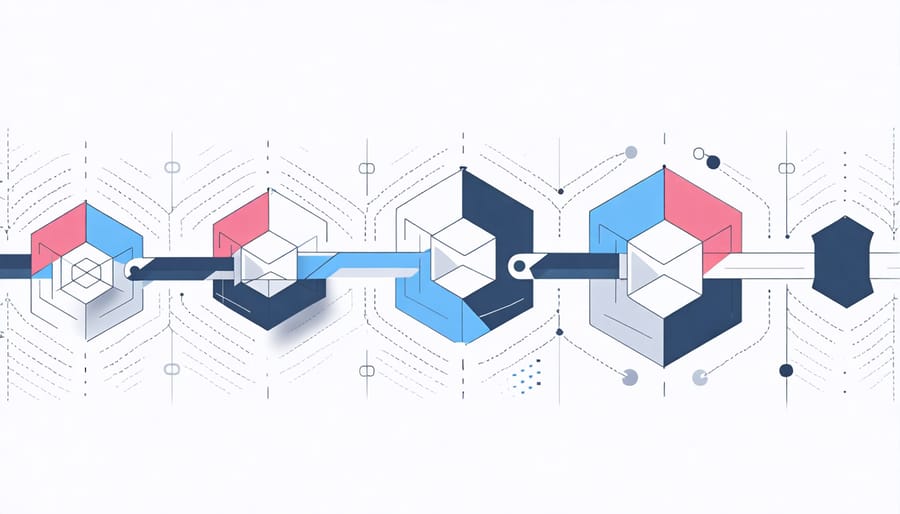Blockchain Traceability Makes Your B2B Transactions Bulletproof

Blockchain technology is revolutionizing supply chain transparency, transforming B2B transactions through immutable, real-time traceability solutions. From farm to factory to retail shelf, organizations now track products with unprecedented accuracy, reducing fraud by up to 83% and cutting verification times by 97%. This distributed ledger technology enables businesses to authenticate product origin, monitor handling conditions, and verify compliance requirements—all while maintaining data integrity through encrypted, tamper-proof records.
For manufacturers, retailers, and logistics providers, blockchain traceability delivers immediate competitive advantages: instant product authentication, automated compliance reporting, and real-time supply chain visibility. Global leaders like Walmart, Maersk, and IBM have already implemented blockchain systems, achieving complete end-to-end transparency while reducing operational costs by 20-30%.
By integrating blockchain into existing supply chain operations, businesses can now offer customers complete product journey transparency, build stronger trust relationships, and maintain regulatory compliance with automated documentation. The technology’s ability to create an unbreakable chain of custody is particularly valuable in industries where authenticity and safety are paramount, such as pharmaceuticals, food safety, and luxury goods.
How Blockchain Transforms B2B Transaction Transparency

Immutable Digital Ledgers
At the heart of blockchain technology lies its defining feature: immutable digital ledgers. Once data is recorded on the blockchain, it cannot be altered or deleted, creating a permanent and transparent record of all transactions and activities. This immutability is achieved through a combination of cryptographic hashing and distributed consensus mechanisms.
Each new record, or block, contains a unique cryptographic hash of the previous block, forming an unbreakable chain. Any attempt to modify existing data would require changing all subsequent blocks across every copy of the ledger maintained by network participants – a practically impossible task.
For businesses implementing traceability solutions, this means every product movement, quality check, or ownership transfer is permanently documented. The system automatically timestamps and validates each entry, eliminating the possibility of backdated records or unauthorized modifications. This creates an audit trail that stakeholders can trust completely, as the integrity of historical data is guaranteed by the blockchain’s architecture.
The immutable nature of blockchain records also helps companies meet regulatory compliance requirements and provides irrefutable evidence in case of disputes or quality issues.
Smart Contracts for Automated Verification
Smart contracts on blockchain platforms revolutionize supply chain verification by enabling automated business processes that execute without human intervention. These self-executing contracts automatically verify compliance with predefined conditions, ensuring that all parties meet their obligations before proceeding to the next stage of the transaction.
For businesses implementing traceability solutions, smart contracts offer several key advantages. They eliminate manual verification processes, reduce administrative overhead, and minimize the risk of human error. When a product moves through the supply chain, smart contracts automatically validate authenticity, quality standards, and shipping conditions against predetermined criteria.
Consider a food supply chain scenario: temperature sensors continuously monitor perishable goods during transport. If temperatures exceed acceptable ranges, smart contracts automatically trigger alerts and create incident reports. This real-time verification ensures product quality and compliance with food safety regulations while maintaining an immutable record of the entire process.
By implementing smart contracts, businesses can achieve greater efficiency, reduce disputes, and maintain consistent quality standards throughout their supply chain operations.
Real-World Applications of Blockchain Traceability
Supply Chain Verification
Blockchain technology revolutionizes supply chain verification by creating an immutable digital ledger of every transaction and movement throughout the product journey. Each step, from raw material sourcing to final delivery, is recorded as a unique block of information that cannot be altered without consensus from network participants.
This verification process works through a series of automated checkpoints. When products move between supply chain partners, smart contracts automatically verify and record the transfer. Each participant must digitally sign off on their role, creating a chain of accountability that helps prevent fraud and ensures authenticity.
For example, in the food industry, blockchain tracking allows companies to trace produce from farm to table within seconds, compared to the days or weeks required by traditional methods. If contamination is discovered, affected products can be immediately identified and recalled, protecting both consumers and brand reputation.
The system also validates certifications and compliance requirements in real-time. Whether it’s organic certification, fair trade status, or quality assurance standards, blockchain provides instant verification of these credentials. This transparency helps businesses maintain regulatory compliance while building trust with partners and customers.
Organizations can implement verification protocols through QR codes, RFID tags, or IoT sensors that automatically update the blockchain. This creates a seamless, trustworthy system that reduces manual verification efforts while providing unprecedented visibility into supply chain operations.

Financial Transaction Monitoring
Blockchain technology has revolutionized financial transaction monitoring by providing unprecedented transparency and security in payment tracking. For businesses, this means real-time visibility into payment flows, automated compliance checks, and reduced fraud risks. Each transaction recorded on the blockchain creates an immutable record, enabling companies to track the movement of funds across multiple parties and jurisdictions.
The implementation of blockchain in financial monitoring brings several key advantages for businesses. First, it automates reconciliation processes, reducing the time and resources traditionally spent on manual verification. Second, it ensures regulatory compliance by maintaining detailed audit trails that can be easily accessed during investigations or audits. Third, it enables instant verification of transaction authenticity, helping organizations detect and prevent fraudulent activities more effectively.
Smart contracts play a crucial role in this ecosystem by automating payment triggers and compliance checks. When predefined conditions are met, payments are automatically executed and recorded, eliminating the need for manual intervention. This automation not only reduces operational costs but also minimizes human error in transaction processing.
For businesses dealing with international payments, blockchain-based monitoring systems offer enhanced visibility into cross-border transactions. The technology enables real-time tracking of payment status, exchange rates, and processing fees, providing better control over international financial operations. This transparency helps organizations optimize their payment strategies and improve cash flow management while maintaining compliance with international regulations.
Implementation Strategy for Your Business
Assessment and Planning
Before implementing blockchain traceability, organizations must conduct a thorough assessment of their current supply chain processes and develop a strategic implementation plan. Start by identifying key pain points in your existing traceability system and specific areas where blockchain can provide tangible improvements.
Create a comprehensive needs assessment checklist that includes:
– Current tracking methods and their limitations
– Data collection points and gaps
– Stakeholder requirements and expectations
– Technical infrastructure capabilities
– Resource availability and constraints
– Compliance requirements and industry standards
Once you’ve completed the assessment, develop a phased implementation roadmap that aligns with your business objectives. This approach allows for personalized business solutions tailored to your organization’s specific needs.
Your implementation roadmap should include:
1. Pilot program scope and objectives
2. Technology selection criteria
3. Integration requirements with existing systems
4. Timeline for deployment phases
5. Training and change management plans
6. Success metrics and KPIs
7. Budget allocation and ROI projections
Remember to involve key stakeholders throughout the planning process and establish clear communication channels. Regular reviews and adjustments will ensure your blockchain implementation stays on track and delivers the desired outcomes.
Integration and Training
Implementing blockchain traceability requires a systematic approach to both technical integration and team preparation. Start by conducting a thorough assessment of your existing systems and identifying integration points where blockchain technology will interface with your current processes.
Work with your IT team or external consultants to develop a detailed implementation roadmap. This should include specific milestones, technical requirements, and timeline estimates. Consider starting with a pilot program in one department or product line before rolling out company-wide.
Staff training is crucial for successful implementation. Organize comprehensive training sessions covering:
– Basic blockchain concepts and terminology
– New operational procedures
– System interface navigation
– Data entry protocols
– Security best practices
Create detailed documentation and standard operating procedures (SOPs) for all blockchain-related processes. This ensures consistency and helps new team members quickly adapt to the system.
Establish a support system for ongoing technical assistance and troubleshooting. This might include internal IT support, vendor helpdesk access, or partnerships with blockchain consultants.
Regular feedback sessions with end-users help identify potential improvements and address challenges early. Schedule periodic reviews to assess system performance and user adoption rates.
Remember to maintain open communication channels between technical teams and operational staff throughout the integration process. This collaborative approach helps ensure smooth implementation and higher user acceptance rates.

Measuring ROI and Performance Impact
Measuring the ROI and performance impact of blockchain traceability implementation requires a systematic approach aligned with broader digital transformation strategies. Start by establishing clear baseline metrics before implementation, including supply chain costs, error rates, and customer satisfaction scores.
Key performance indicators (KPIs) for blockchain traceability typically include:
– Time reduction in tracking products
– Decrease in documentation errors
– Improved supplier compliance rates
– Customer trust and satisfaction levels
– Reduction in fraud-related losses
– Supply chain efficiency gains
To effectively measure ROI, organizations should:
1. Track direct cost savings from reduced manual verification processes
2. Monitor the decrease in product recalls and associated costs
3. Measure improvements in inventory management efficiency
4. Calculate the value of increased customer trust and retention
5. Assess the impact on regulatory compliance costs
Consider both quantitative and qualitative metrics when evaluating performance. Quantitative measures might include processing time reduction (often 40-60% with blockchain implementation) and error rate decrease (typically 20-30% in the first year). Qualitative improvements often manifest in enhanced stakeholder relationships and brand reputation.
Create a balanced scorecard approach that incorporates:
– Financial metrics (cost savings, revenue impact)
– Operational efficiency (process improvements)
– Customer perspective (satisfaction, trust)
– Innovation potential (new business opportunities)
Regular performance reviews, preferably quarterly, help identify areas for optimization and ensure the system delivers expected benefits. Remember that ROI may take 12-18 months to fully materialize as systems and processes mature. Document both direct financial returns and indirect benefits like improved market positioning and competitive advantage to present a complete picture of the implementation’s value.
Blockchain traceability represents a transformative solution for businesses seeking to enhance transparency, security, and efficiency in their supply chain operations. By implementing this technology, organizations can achieve end-to-end visibility, reduce fraud, and build stronger trust with partners and customers.
The key benefits we’ve explored – from immutable record-keeping to real-time tracking and automated compliance – make a compelling case for adoption. However, successful implementation requires a strategic approach. Begin by identifying specific pain points in your current traceability system and defining clear objectives. Next, assess your technical capabilities and consider partnering with experienced blockchain solution providers who understand your industry requirements.
Start small with pilot projects focusing on high-priority products or processes. This approach allows you to demonstrate value while minimizing risk. Ensure proper staff training and stakeholder buy-in throughout the implementation process. Consider developing a phased rollout plan that accounts for both technical integration and organizational change management.
Remember that blockchain traceability is not just a technological upgrade – it’s a business transformation tool. The investment in this technology can lead to improved operational efficiency, reduced costs, enhanced customer trust, and competitive advantage in an increasingly transparent marketplace. By taking action now and following a structured implementation approach, businesses can position themselves at the forefront of supply chain innovation and meet growing demands for transparency and accountability.
Leave a Reply